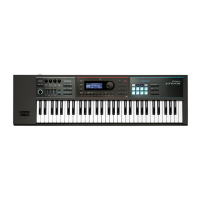48
MFX/Chorus/Reverb Parameters
32: 2BAND CHORUS
A chorus eect that lets you apply an eect independently to the low-frequency
and high-frequency ranges.
Split
High Band Chorus
Low Band Chorus
High Band Chorus
Low Band Chorus
Split
Parameter Value Explanation
Split Freq 200–8000[Hz]
Frequency at which the low and high ranges will
be divided
Low Pre Delay 0.0–100[msec]
Delay time from when the original sound is
heard to when the low-range chorus sound is
heard
Low Rate # 0.05–10.00[Hz], note
Rate at which the low-range chorus sound is
modulated
Low Depth 0–127
Modulation depth for the low-range chorus
sound
Low Phase 0–180[deg] Spaciousness of the low-range chorus sound
High Pre Delay 0.0–100[msec]
Delay time from when the original sound is
heard to when the high-range chorus sound is
heard
High Rate # 0.05–10.00[Hz], note
Rate at which the high-range chorus sound is
modulated
High Depth 0–127
Modulation depth for the high-range chorus
sound
High Phase 0–180[deg] Spaciousness of the high-range chorus sound
Balance # D100:0W–D0:100W
Volume balance of the original sound (D) and
chorus sound (W)
Level 0–127 Output level
33: 2BAND FLANGER
A anger that lets you apply an eect independently to the low-frequency and
high-frequency ranges.
Split
High Band Flanger
Low Band Flanger
High Band Flanger
Low Band Flanger
Split
Low Band Feedback
High Band Feedback
High Band Feedback
Low Band Feedback
Parameter Value Explanation
Split Freq 200–8000[Hz]
Frequency at which the low and high ranges will
be divided
Low Pre Delay 0.0–100[msec]
Delay time from when the original sound is
heard to when the low-range anger sound is
heard
Low Rate # 0.05–10.00[Hz], note
Rate at which the low-range anger sound is
modulated
Low Depth 0–127
Modulation depth for the low-range anger
sound
Low Phase 0–180[deg] Spaciousness of the low-range anger sound
Low Feedback # -98–+98[%]
Proportion of the low-range anger sound that
is to be returned to the input (negative (-) values
invert the phase)
High Pre Delay 0.0–100[msec]
Delay time from when the original sound is
heard to when the high-range anger sound is
heard
High Rate # 0.05–10.00[Hz], note
Rate at which the high-range anger sound is
modulated
High Depth 0–127
Modulation depth for the high-range anger
sound
High Phase 0–180[deg] Spaciousness of the high-range anger sound
High Feedback # -98–+98[%]
Proportion of the high-range anger sound that
is to be returned to the input (negative (-) values
invert the phase)
Balance # D100:0W–D0:100W
Volume balance of the original sound (D) and
anger sound (W)
Level 0–127 Output level
34: 2BAND STEP FLNGER
A step anger that lets you apply an eect independently to the low-frequency and
high-frequency ranges.
Split
High Band Step Flanger
Split
Low Band Feedback
High Band Feedback
High Band Feedback
Low Band Feedback
Low Band Step Flanger
High Band Step Flanger
Low Band Step Flanger
Parameter Value Explanation
Split Freq 200–8000[Hz]
Frequency at which the low and high ranges will
be divided
Low Pre Delay 0.0–100[msec]
Delay time from when the original sound is
heard to when the low-range anger sound is
heard
Low Rate # 0.05–10.00[Hz], note
Rate at which the low-range anger sound is
modulated
Low Depth 0–127
Modulation depth for the low-range anger
sound
Low Phase 0–180[deg] Spaciousness of the low-range anger sound
Low Feedback # -98–+98[%]
Proportion of the low-range anger sound that
is to be returned to the input (negative (-) values
invert the phase)
Low Step Rate # 0.10–20.00[Hz], note
Rate at which the steps will cycle for the low-
range anger sound
High Pre Delay 0.0–100[msec]
Delay time from when the original sound is
heard to when the high-range anger sound is
heard
High Rate # 0.05–10.00[Hz], note
Rate at which the high-range anger sound is
modulated
High Depth 0–127
Modulation depth for the high-range anger
sound
High Phase 0–180[deg] Spaciousness of the high-range anger sound
High Feedback # -98–+98[%]
Proportion of the high-range anger sound that
is to be returned to the input (negative (-) values
invert the phase)
High Step Rate # 0.10–20.00[Hz], note
Rate at which the steps will cycle for the high-
range anger sound
Balance # D100:0W–D0:100W
Volume balance of the original sound (D) and
anger sound (W)
Level 0–127 Output level
35: OVERDRIVE
Creates a soft distortion similar to that produced by vacuum tube ampliers.
Amp
Simulator
2-Band
EQ
Over
drive
Pan R
Pan L
Parameter Value Explanation
Drive # 0–127
Degree of distortion
Also changes the volume.
Amp Type
Type of guitar amp
SMALL Small amp
BUILT-IN Single-unit type amp
2-STACK Large double stack amp
3-STACK Large triple stack amp
Low Gain -15–+15[dB] Gain of the low range
High Gain -15–+15[dB] Gain of the high range
Pan # L64–63R Stereo location of the output sound
Level 0–127 Output level
36: DISTORTION
Produces a more intense distortion than Overdrive. The parameters are the same as
for “35: OVERDRIVE.”
Pan R
Pan L
Amp
Simulator
2-Band
EQ
Distortion
3
3
3
3

